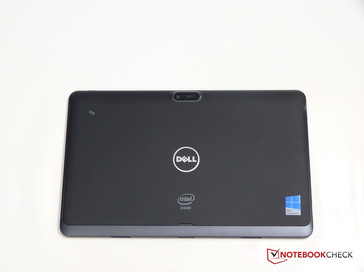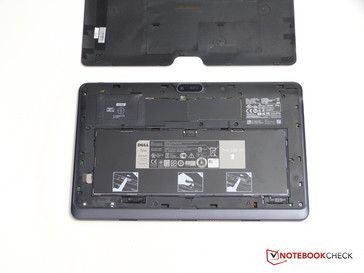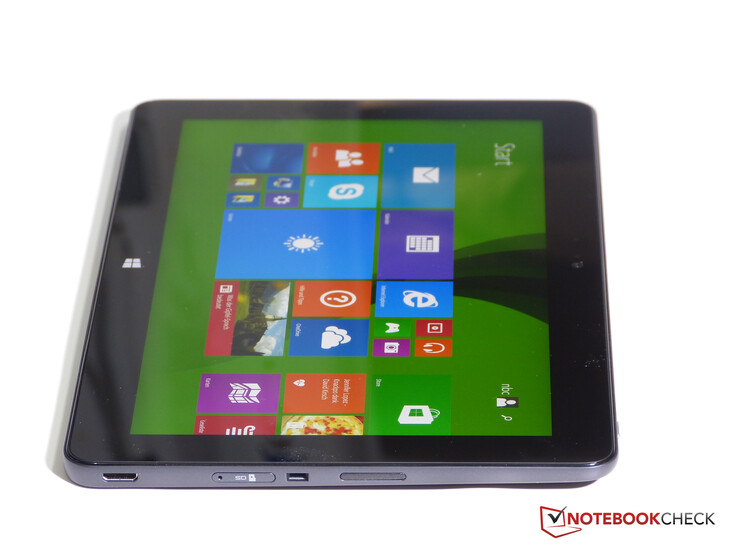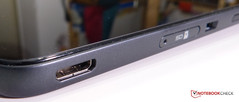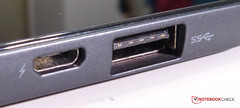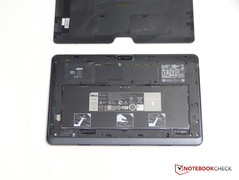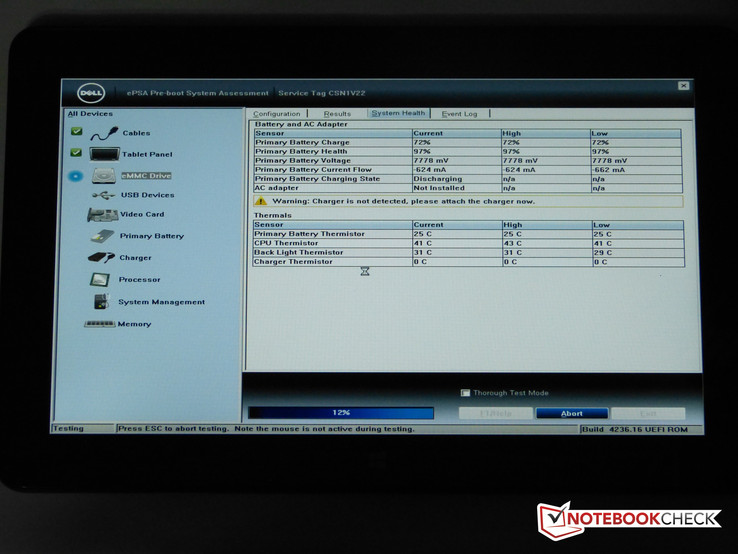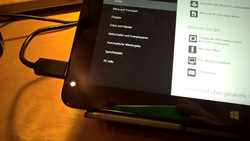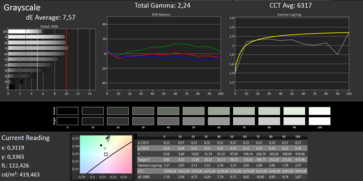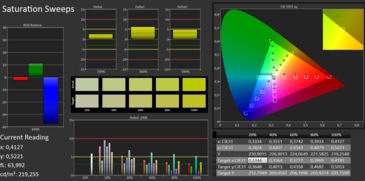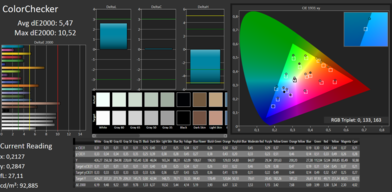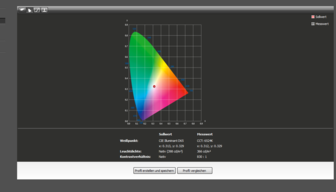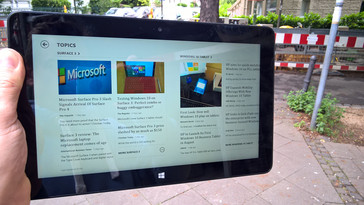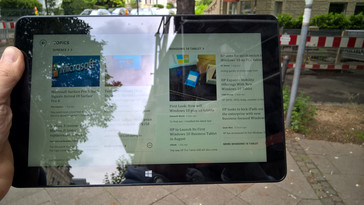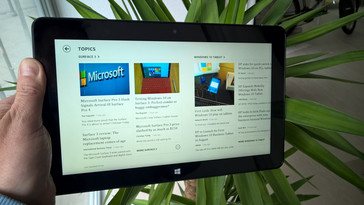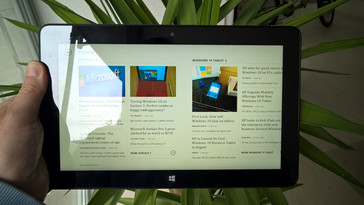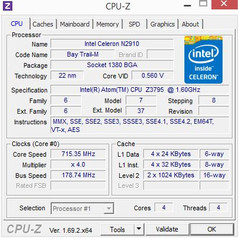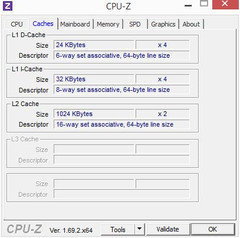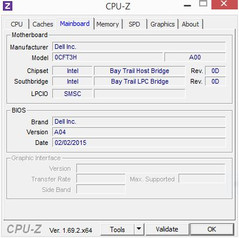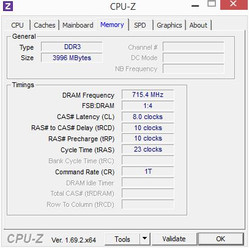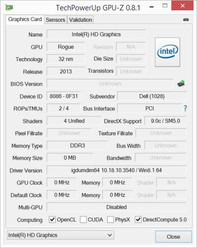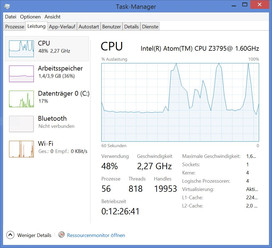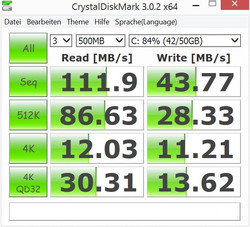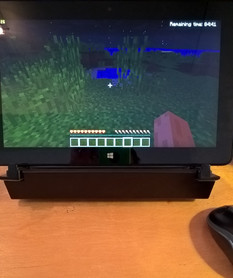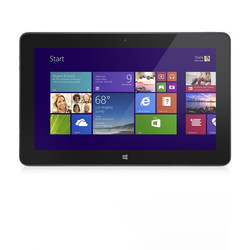Dell Venue 11 Pro 5130-9356 Tablet Review

Just as the Surface 3 reaches the market Dell have slightly upgraded their high-end Venue 11 Pro Atom variant with the highest-performance processor in the Baytrail-M range. The Z3795 has a little more power than other Atom processors, supports 64-bit operating systems fully and has been paired here with a useful 4GB of RAM. The full HD screen, removable battery, NFC, large range of accessories and Windows 8.1 Pro OS tick all the 'work' boxes but there are still a few limitations. EMMC storage is one of them. The Dell Venue 11 Pro and accessories are slightly more business-oriented than the Surface 3. The Lenovo Thinkpad 10 and HP ElitePad 1000 G2 are closer in target audience.
We're taking a deep look at the tablet in this review we advise readers to reference our previous Dell Venue 11 Pro 5130 review which also covers one of the keyboard options. This Dell Venue 11 Pro 5130 tablet (only) is currently around $599 at Dell.com,
Case
Quality seems to be good all round on the Dell Venue 11 Pro although it's not a real eye-pleaser. There's no metal and it's all dark-grey in color. The rubberized rear is grippy but gets very dirty with slightly greasy fingers. The tablet is wide and at 770 grams it's not the tablet you want to be holding in landscape mode with one hand. Portrait mode is obviously easier but it still feels a little heavy. The Surface 3 weighs just 622 grams - 20% less.
On the rear of the Venue 11 Pro you'll find a removable snap-in section that reveals a user-swappable, 32 Wh battery which is great if you want to buy and charge a second battery or drop in a replacement. There's access to the SIM card slot for 4G versions here too but no easy access to memory or storage.
Docking locators and port are included on the bottom edge of the tablet along with a connector for the two keyboard accessories and the docking station that can be bought separately.
Connectivity
The Dell Venue 11 Pro 5130 offers a good set of connectivity options including a full size USB 3.0 port and NFC. There's also a mini HDMI port, micro SD card slot (covered) and a dual-rate Micro USB charging port that can switch to 19 V charging with the included charger. NFC can be used in combination with Bluetooth and WiFi to authorize tap-and-share which we tested by sending a photo from a Lumia 830 smartphone.
Communication
Internally you'll find a Dell wireless a/g/n adapter so there's no AC WiFi support here, something that's becoming more and more common as we go through 2015. WiFi N connection was seen connected at 300 Mbps with a file copy from a local NAS being received at 13 MB/s - possibly being limited by the eMMC write speed. Bluetooth 4.0 is also included. There are options for 4G modules with the Dell Venue 11 Pro but we don't have one installed in our test device.
Security
Security is a prominent feature in the Dell Venue 11 Pro from BIOS setup to Bitlocker. Windows 8 Pro gives the user full Bitlocker disk encryption with local key management if desired. Secure Boot, a BIOS and boot password ensures that USB booting is not possible and many of the ports and features can be toggled on or off from within the BIOS. The camera, for example. There's no fingerprint reader or RealSense camera here that could be used with Windows Hello, arriving with Windows 10. Upgrading to Windows 10 is expected to be problem-free and that will provide more security improvements through sandboxed Universal Apps. We didn't test Windows 10 preview build.
For screenshots of all BIOS options, see the full gallery above.
Camera
There's a rear 8 mega-pixel camera with auto-focus and a 2 mega-pixel camera on the front. Dual mics help improve audio performance in noisy environments. See the image samples below for outdoor, indoor and close-up image. Indoor low-light performance on the front camera isn't very good at all but the rear camera is fine for snapshots and business cards.
Input Devices
We've only got the tablet in review here but you'll find the keyboard covered in our previous review of the Dell Venue 11 Pro with the Z3770 CPU. The touchscreen experience is as expected of a 'pro' tablet with 10-point touch on a coated touchscreen with Windows 8.1. By now you'll probably be aware that the Windows Desktop isn't very finger friendly but that in Windows 10 you'll start to see more finger-friendly apps available for the desktop through the Universal Windows Platform (UWP) which includes apps that have to run on smartphones and phablets as well as on large-screen Windows 10 devices. We're testing the Dell Venue 11 Pro with Windows 8.1 and the 'Metro' environment of Windows Store apps is good. An extended session with Wordament, an app that easily shows up the limits of touch input, worked perfectly. Drift Mania: Street Outlaws also played smoothly proving that the accelerometer is responsive.
USB Docking
We don't have the keyboard but we do have a USB docking station here. The Belkin USB 3.0 DisplayLink dock works by connecting up to two external screens, a Gigabit Ethernet, secondary audio device and USB hub via one USB 3.0 connector. In comparison to a Surface Pro 3 connected to the same dock the experience was a little slower but that's to be expected when comparing an Atom device against a Core i5 device. The screen performance is smooth (no noticeable lag) and is better than we've seen on USB 2.0 based devices. The 4 GB RAM, Z3795 and USB 3.0 port all combine here to make the experience much more desktop like. The same three 'features' can also be found in the Surface 3.
There are limits to what the Dell Venue 11 Pro 5130-9356 can do as a desktop and the user is well advised to keep the number of concurrently running apps down to a minimum to avoid loading the CPU too much. 4 GB RAM should be enough for most office-stlye operations but heavy Photoshop or video work may overload but CPU and RAM resulting in 'swapping' which completely kills the user experience. (Simple 720p is about the limit for video editing.)
Display
Like most of the screens in the Dell Venue tablet range the quality is high as is the brightness and contrast. To the eye it looks every bit as good as a Surface Pro 3 (that we have alongside the Dell as we review.) The wide aspect ratio may not suit some people and the frame is relatively thick but at least there's a good area to hold the device in.
Let's take a look at the test results.
| |||||||||||||||||||||||||
Brightness Distribution: 89 %
Center on Battery: 426 cd/m²
Contrast: 1121:1 (Black: 0.38 cd/m²)
ΔE ColorChecker Calman: 5.47 | ∀{0.5-29.43 Ø4.78}
ΔE Greyscale Calman: 7.57 | ∀{0.09-98 Ø5}
68.1% AdobeRGB 1998 (Argyll 3D)
96.2% sRGB (Argyll 3D)
66.1% Display P3 (Argyll 3D)
Gamma: 2.24
CCT: 6317 K
The first thing to note is the maximum brightness which is almost as good as the Dell Venue 10 Pro, quite a bit more than the 355 nits on the Surface Pro 3 and 409 nits on the Microsoft Surface 3. The average brightness level seen across the screen was 398.4 nits which will really help in bright-light situations, although it's still not enough for comfortable outdoor reading unless you're reflecting a dark or shadowed area. (See the images below)
The Surface 3, a direct competitor, returned excellent color results in our tests and the Dell Venue 11 Pro does so too but in different way. The black levels are better than the Surface Pro 3 with the contrast at an impressive 1121:1 but the Surface 3 wins in the color accuracy tests. The average color deviation on the Dell Venue 11 Pro is 5.47 (1.66 for the Surface 3) and for greyscale its 7.57 (2.75 for the Surface 3.) We don't have Adobe RGB coverage figures for you unfortunately.
As mentioned, the Dell Venue 11 Pro 5130 returns great brightness but it's still not enough for trouble-free sunlight usage. A bright outdoor area with a bit of shade should be fine though and you can see the difference that different reflections make. Even a bright cloudy sky can be a problem when it is reflected, either indoors or outdoors.
Performance
The Dell Venue 11 Pro 5130-9356 sits in the high-end of the range of Intel Atom-based tablets, just where the new Surface 3 has arrived and although the Dell might be a little more angled towards business usage than the Surface 3 the two devices are similar in performance. We've made direct comparisons throughout this section.
The Intel Atom Z3795 CPU is slightly unique in it's ability to run 64-bit operating systems. Although other Atom CPUs use a 64-bit architechture they can only, due to bootloader/UEFI restrictions, run 32-bit operating systems. This isn't a big issue for the consumer but it does mean that it's difficult to boot certain Linux builds. It also means that companies can focus on purely 64-bit operating system image roll-outs. The Atom X7 used in the Surface 3 is also a fully 64-bit capable platform.
Clock rates between the Intel Atom Z3795 and the Intel Atom x7-Z8700 CPU are similar and it turns out that CPU performance is close too. The only big differences beteween the two are the GPU design which is stronger in the Atom X7.
The Atom Z3795 also supports Intel Quick Sync for hardware video decode and encode
If you take a look at the Cinebench CPU test results below you'll see the Dell coming in just underneath the Surface 3, but not by much. On the latest Cinebench R15 CPU test the figures are within 3% of each other. The Surface Pro 3 has about 2X the CPU power of the Dell Venue 11 Pro (with Atom Z3795.) Naturally these tests are synthetic and in normal use the memory and disk speed play an important role in the perceived performance of a PC.
| Cinebench R10 | |
| Rendering Single CPUs 64Bit (sort by value) | |
| Dell Venue 11 Pro 5130-9356 | |
| HP ElitePad 1000 G2 | |
| Microsoft Surface Pro 3 | |
| Rendering Multiple CPUs 64Bit (sort by value) | |
| Dell Venue 11 Pro 5130-9356 | |
| HP ElitePad 1000 G2 | |
| Microsoft Surface Pro 3 | |
System Performance
A more rounded, real-world benchmark result comes via PCMark 7 where we can compare overall performance with some scenario-specific results.
The newer PCMark 8 results are also shown below for comparison with future devices.
| PCMark 7 Score | 2653 points | |
| PCMark 8 Home Score Accelerated v2 | 1225 points | |
| PCMark 8 Creative Score Accelerated v2 | 1191 points | |
| PCMark 8 Work Score Accelerated v2 | 1228 points | |
Help | ||
Storage Devices
Using Crystal DiskMark we tested the performance of the 64 GB eMMC storage both with and without Bitlocker disk encryption enabled. The results are shown in the table below and are comparable to other Atom-based / eMMC storage figures but compared to a Surface Pro 3, with a SATA-connected SSD, the results aren't that impressive. Large file transfers, indexing operations, updates and software installations can be affected by the low write speeds. Bitlocker doesn't appear to make any difference with the variance so small as to be irrelevant. The image, right, shows the performance scores with Bitlocker disabled.
Graphics Solution
The integrated graphics unit is based on Intel's HD graphics Gen-7 architecture, at a time when Gen-8 is now in the newest Atom-based Windows tablets and it's hear that we'll see the biggest difference between the Dell Venue 11 Pro 5130 and the Surface Pro 3. We've run through some GPU benchmarks, run a couple of gaming tests and have added information about Quick Sync performance - GPU accelerated video encoding for video file conversion and rendering.
| 3DMark 11 Performance | 202 points | |
Help | ||
| 3DMark 11 - 1280x720 Performance (sort by value) | |
| Dell Venue 11 Pro 5130-9356 | |
| Microsoft Surface 3 | |
| Lenovo ThinkPad 10 | |
| HP ElitePad 1000 G2 | |
| Microsoft Surface Pro 3 | |
| Cinebench R15 - OpenGL 64Bit (sort by value) | |
| Dell Venue 11 Pro 5130-9356 | |
| HP ElitePad 1000 G2 | |
| Microsoft Surface 3 | |
| Cinebench R11.5 - OpenGL 64Bit (sort by value) | |
| Dell Venue 11 Pro 5130-9356 | |
| HP ElitePad 1000 G2 | |
| Microsoft Surface 3 | |
| Microsoft Surface Pro 3 | |
Gaming Performance
There never has been, and there never will be, a gaming-capable Atom Baytrail based device. By that we mean a device that could perform a reasonable level of PC gaming with raw desktop applications. Our entry level tests were done with World of Warcraft and Minecraft.
Minecraft plays quite smoothly with graphics set to Fast but we have to admit that we didn't get that far into the game with this test and there's not a lot of action in the test scene. Fraps showed a frame rate of between 20 and 30 FPS.
World of Warcraft requires either a very clean disk or additional storage so given that we had just 6 GB of storage free after installing all of our test software we installed WoW on a USB 3.0 SSD which worked well but doesn't help the Dell Venue 11 Pro get over the need to push 1920 x 1024 pixels for every frame of the game. It shows in the results which were surprisingly low. Note: If you use an external drive for game storage you'll also need to use a hub for keyboard and mouse controls as there's only one USB port.
The Windows Store experience is good and this is where users should focus for a quick, smooth game experience. We enjoyed the graphics, responsiveness and sound from Drift Street Mania Outlaws Lite.
| low | med. | high | ultra | |
|---|---|---|---|---|
| World of Warcraft (2005) | 33 | 22 | 12 |
Video Conversion
In order to test the Intel Quick Sync video encoding hardware we took a recent copy of Handbrake (link) and converted the Big Buck Bunny 1920x1080 H.264 video (link) down to 1280x720 using Handbrake's Quick Sync support.
- Dell Venue 11 Pro 5130 (Z3795) - 145 FPS average
- Surface Pro 3 (Core i5) - 295 FPS average
- ASUS Vivotab Note 8 (Z3740) - 117 FPS average
- Surface 3 - not tested.
Handbrake was setup with a picture size width of 1280 and the H.264 Intel QSV video codec with a QSV preset value of Best Speed. [If anyone is able to test a Surface 3 under these conditions it would be interesting to see the results.]
The results are impressive for an Atom device.
Authors note: Given the RAM available it might be possible to edit simple 1080p videos with this platform. I have tested many basic Atom platforms with Cyberlink Power Director using the Intel Quick Sync rendering encoder but they are really only good enough for 720p. The performance advantage of the Z3795 (and probably Atom X7-series processors too) leads me to believe that 1080p editing would be possible. Unfortunately I have not had the time to test this during the review.
Emissions
System Noise
The Dell Venue 11 Pro 5000-series are all fanless and therefore silent tablets.
Temperature
Temperature levels in normal use are good and even after playing a game for 20 minutes there were no warm patches under our fingers. Any warmth generated under load can be felt just underneath the webcam on the rear of the unit which is the best place for it.
(±) The maximum temperature on the upper side is 44 °C / 111 F, compared to the average of 33.7 °C / 93 F, ranging from 20.7 to 53.2 °C for the class Tablet.
(-) The bottom heats up to a maximum of 49.2 °C / 121 F, compared to the average of 33.2 °C / 92 F
(±) In idle usage, the average temperature for the upper side is 33 °C / 91 F, compared to the device average of 30 °C / 86 F.
Speakers
The speakers, situated on each side of the tablet in landscape mode, work well unless you hold the tablet tightly from the middle. Most users will hold the unit at the bottom though where the speakers are generally free to be heard at their best. The speakers are good enough for personal use but aren't powerful to fill a room with anything but background music.
Energy Management
Power Consumption
Power consumption at the wall looks fine and proves that the 'USB' charger can switch into high-power charging mode under load.
| Off / Standby | |
| Idle | |
| Load |
|
Key:
min: | |
Battery Life
In general, mot of the Atom-based Windows tablets have very similar battery life figures under our test conditions. One thing to note with the Dell Venue 11 Pro 5130 is the high screen brightness which is only made possible by using more / powerful backlighting LEDs. In our tests we saw a 2.3 W drain difference between minimum and maximum brightness which , at idle, would half the battery life.
Fortunately Dell appear to have squeezed a little bit more out of the Venue 11 Pro 5130 than we were expecting. A low 2.3 W idle drain rate resulting in nearly 14 hours of idle time and an impressively long video playback figure of 10 hours i(with the screen brightness set as low as was comfortable in a dimly lit room, simulating an aircraft experience) points to a high quality mainboard. Note that video playback was done with the Windows 8 Video application and the browsing test was done with the Windows 8.1 Explorer app. Chrome consistently uses more battery than Internet Explorer, especially when it comes to video playback.
The built-in powercfg command reports that standby battery life was very good and our average projected 100% battery life per day was... between 4.5 and 6.5 hours.
Pros
Cons
Verdict
We were hoping to see a real competitor to the Surface 3 in the Dell Venue 11 Pro 5130 (with Z3795 and 4GB RAM) but it turns out that this Windows tablet is much more business-oriented than the Surface 3. The removable battery, NFC support, BIOS features, multi-rate USB charging, Windows 8.1 Pro (upgradable to Windows 10 Pro) and accessory range that includes protective covers and different keyboard types fits well with the business user, educational users and in other verticals. Build quality, both inside and out, appears to be very good.
The Dell Venue 11 Pro can't compete with devices like the Apple iPad Air or Sony Xperia Z4 tablet but that's not where it's targeted.
We enjoyed the high contrast and high brightness screen despite the color accuracy being a little off but there is the issues of tablet weight to consider. Relative to some consumer-facing devices in this tablet class it's not competitive. The Dell Venue 11 Pro can't compete with devices like the Apple iPad Air or Sony Xperia Z4 tablet but that's not where it's targeted. Devices like the The Lenovo Thinkpad 10 and HP ElitePad 1000 G2 are closer comparisons.
At $599 the pricing is acceptable but we would advise potential buyers to keep an eye out for offers. The Dell Venue 11 Pro 5130 is built around a processor that was first available in 2013 and now that the Atom X5 and X7 ranges are available it could be time for Dell to update and relaunch this model. With that in mind we don't expect this model to stay around for long and we expect to see discounting. If snap up the Dell Venue 11 Pro 5130 with 4GB RAM and the Z3795 CPU with a $100 discount you'll end up being happy.
Dell Venue 11 Pro 5130-9356
- 06/24/2015 v4 (old)
Steve Chippy Paine




